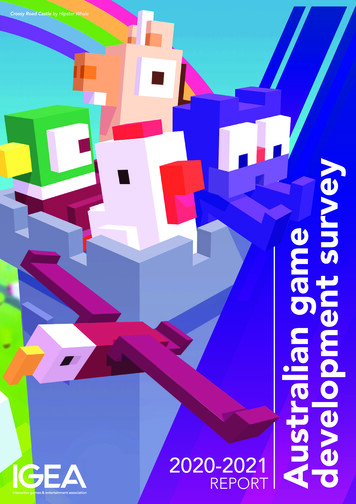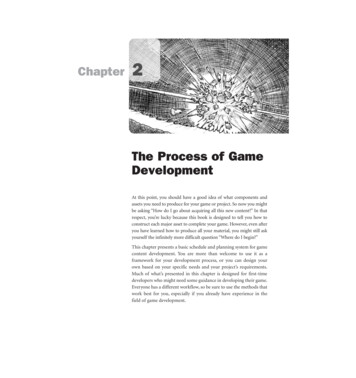
Transcription
A reminder to government ofthe value in supporting athriving games developmentindustry and recommendationsfor industry supportDecember 2018
A b o ut IG E AThe Interactive Games & Entertainment Association (IGEA) is the peak industry associationrepresenting the business and public policy interests of Australian and New Zealandcompanies in the computer and video games industry. Our members publish, market,develop and distribute interactive games, entertainment content and related hardware.Our mission is to create an environment that drives sustainable growth for the interactivegames and entertainment industry.IGEASuite 145, National Innovation CentreAustralian Technology Park4 Cornwallis St, Eveleigh NSW 2015www.igea.netinfo@igea.net@igea/igea.net
C O NTE NTSAbout IGEAIFCSummary2Table of policy recommendations3Why Australia needs an interactive games industry41. Game development is an innovative and future-looking creative industry42. Game development will help build a modern and talented Australian workforce53. Games are a valuable, IP-driven and weightless export with high global demand 74. We have entered an era of serious games and their uses have limitless potential85. The power of games for digital inclusion and its cultural dividend for Australia 10Blueprint for fostering a strong Australian game development industry121. Provide a 40 million fund for game development122. Create a 30 per cent refundable tax offset for game development143. Provide strategic support for cultural, educational and serious games164. Additional funding and policy support to foster a game development industry 16The fiscal and economic case for supporting game development181. The cost of supporting game development is modest and sustainable182. Games funding is recoupable, while a tax offset will lead to increased tax receipts 193. Financial incentives will provide a lightning rod for foreign investment194. The benefits of investment and growth will more than justify support costs215. Savings are available to offset the cost of funding game development22Game development enjoys broad political and stakeholder support231. There is bi-partisan and crossbench support for games232. The screen industry and the Australian public support games24Building a Thriving Interactive Games Development Industry in Australia1
SUMMARYS um m ar yGame development is an industry ofthe future that will provide highly skilledemployees, high paying jobs and thecreation of digital exports in one of thefastest growing creative, entertainmentand technology sectors in the globaleconomy. There is a need for Australia tomodernise and diversify its economy forthe 21st century and games can help leadthis digital evolution.Australia’s game development industry isa sleeping giant and with the right supportit can employ thousands of people andadd hundreds of millions of dollarsto Australia’s GDP. In particular, it canhelp to build a whole new generation ofAustralians with vital digital skills. This isnot a hypothetical scenario, with Canadaand the United Kingdom providing provenand concrete examples of what can beachieved.Games provide wonderful entertainmentbut also so much more. Serious gamesare finding innovative uses in sectorsincluding health, education, defenceand business. Games are also vital toAustralian culture and support digital andsocial inclusion. Of Australia’s varioustypes of screen content, games arguablyprovide the most relevant and effectiveform of cultural export and can help theworld and particularly the countries withinour region to better understand Australiaand its people.While both federal and state andterritory governments have a role to playto help build a thriving game developmentindustry in Australia, this paper focuses onmapping out the effective and sustainableinvestment and support that is needed atthe federal level.2The most vital financial incentives that areneeded from the Australian Governmentare a 40 million Australian InteractiveGames Fund based on the fund thatpreviously existed in 2013, and a 30 percent refundable tax offset for gamedevelopment modelled off the successfultax offset for Australia’s post-production,visual and digital effects industry.In addition to a new fund and tax offset,other targeted funding and supportmeasures are also outlined in this paper,including support for culturally-significantand serious games, support for co-workingspaces and potential re-calibration ofExport Market Development Grants andResearch & Development tax incentives tobetter suit game development.These financial incentives and supportmeasures will kick start the rapid growthof our game development sector throughthe establishment of new game studios inAustralia, investment and projects flowinginto Australian businesses and a range ofjoint ventures.The costs of government support for agame development sector will easily berecouped through economic growthand increased tax receipts, particularlygiven the export-driven global market forgames. The social and cultural benefits ofAustralian-made games and the increasedopportunities for training and education ofstudents and young graduates that wouldresult from industry support will be furtherreturns on the government’s investment.Finally, these industry support measurescan be introduced via a budget-neutralpackage funded through savings that canbe found by streamlining and modernisingthe government’s existing framework offinancial incentives for the broader screenindustry.Building a Thriving Interactive Games Development Industry in Australia
Ta b l e of p ol ic yrecom m end a t io n sPolicy recommendationWhat it will achieveReinstate the Australian Interactive Games Seed funding to help game developmentFund and provide support of 40 millionbusinesses to expand, encourage newover four yearsbusinesses and multiply projects, privateinvestment, employment and expenditureProvide strategic funding and support forcultural, educational and serious gamesTargeted funding to encourage thedevelopment of games with culturallysignificant Australian content, games witha high educational focus and games witha ‘serious’ focus, an emerging and highpotential sector of the industryTABLE OF POLICYRECOMMENDATIONSProvide a 30 per cent refundable tax offset In addition to the benefits above, it willfor video game developmentdraw global game developers to work orbase in Australia, potentially setting upstudios with hundreds of jobs each andbringing over projects worth tens of millionsin expenditure, if not moreProvide additional funding and support for Targeted support as recommended orgame developers, such as to:discussed by various Parliamentaryinquiries to help game developers to break Provide assistance for shared workinginto the industry and take advantage ofspacesexisting industry support mechanisms Establish a regional innovation hub Review taxation of crowd-sourcedfunding Review Export Market DevelopmentGrants Review Research & Development taxincentivesBuilding a Thriving Interactive Games Development Industry in Australia3
W hy A us tr alia n e e d s a ni n ter acti v e g a me s in d u st r y1. Game development is an innovativeand future-looking creative industryWHY AUSTRALIA NEEDS ANINTERACTIVE GAMES INDUSTRYInteractive games have the wonderfulability to tell unique and compelling storiesthat provide a voice for Australian contentcreators and can provide a key pillar ofa modern, digital and creative Australia.At the same time, games representthe perfect intersection of Australia’stechnology, information and creativeindustries and if supported, they can driveAustralia’s economic growth, productivityand competitiveness in the 21st century.4The interactive games sector is oneof the largest and fastest growingentertainment and media industries inthe world. Estimated to be worth almostAUD 200 billion globally in 2018,1 gamesare bigger businesses than films, musicand books. By contrast, the Australiangame development industry employedaround 928 full-time employees andgenerated just 118.5 million in 20167.2 Disappointingly, Australian gamedevelopers only capture 0.08 per cent ofthe global market, but this also means theopportunities for growth are enormous.1 Tom Wijman, ‘Mobile revenues account for more than 50%of the global games market as it reaches 137.9 billion in2018’, Newzoo, 30 April 2018, ake-half2 IGEA, Australian Video Game Development IndustrySnapshot 2016-7, 17 January 2018, -supportThe size of our industry has not reachedanywhere near its potential and wasoutpaced by even the New Zealand gamedevelopment industry, which generatedAUD 131 million in the 12 months toMarch 2018 and has grown 43 per centsince the preceding year.3 However, it isnot too late and with the right support, anAustralian game development industry canbecome a powerhouse of the economy.Twenty years ago, Canada was in asimilar position to where we are todaywith just 1,000 people employed in gamedevelopment. Aided by governmentsupport, it has grown to an industry thatemploys 21,700 full-time workers and addsAUD 4 billion to its GDP, a growth of 24per cent since 2015.4 The UK also showswhat can be achieved with governmentinvestment and now has 2,261 gamedevelopment companies – 62 per centof which were created this decade –employing 13,840 full-time workers.53 NZ Game Developers Association, NZ GamesDevelopment Industry, https://nzgda.com/about-us/nzgamedev4 ESA Canada, Essential facts about the Canadian videogame industry, 17 Booklet 13 Digital.pdf, p 35 UKIE, The games industry in numbers, https://ukie.org.uk/researchBuilding a Thriving Interactive Games Development Industry in Australia
A competitor but also a vision for the future:the Canadian game development industryThere are 596 video game studios in Canada, a 21 per cent increase since 2015.Canada’s game development industry employs 21,800 workers and is worthCAN 3.7 billion, with 83 per cent of game studios being Canadian-owned andcontrolled. Canadian game studios are spread around the country with 198companies in Quebec, 171 in Ontario and 152 in British Columbia. 2,100 videogame projects were completed in Canada in 2017, a 67 per cent increase since2015. 15 per cent of games completed in Canada in 2017 were serious games,while 23 per cent of developers worked on a virtual reality game.ESA Canada, Essential facts about the Canadian video game industry, 17 Booklet 13 Digital.pdf2. Game development will helpbuild a modern and talentedAustralian workforceA home-grown game developmentindustry will nurture Australia’s nextgeneration of entrepreneurial, skilledand knowledge-based workers. Thebusinesses and jobs that will be createdthrough games can literally be locatedanywhere in the country and can supportregional Australia. For example, theAustralian game Crossy Road by HipsterWhale, which has been downloadedover 100 million times around the worldand is an unbridled success story, wasdeveloped in the town of Creswick north ofBallarat. The TAFE NSW Digital Lab, whichis helping to apply digital technologies likethose developed in the games industryto education, is based in Armidale. Manyof the jobs that will be created will alsobe high paying, with the average salaryof a full-time worker in Canada’s gamedevelopment industry currently payingAUD 85,000.66 ESA Canada, p 7WHY AUSTRALIA NEEDS ANINTERACTIVE GAMES INDUSTRYBuilding a Thriving Interactive Games Development Industry in Australia5
Thriving game development businesseswill also fuel other parts of the interactivegames industry, including gamepublishing, hardware and accessories,exhibitions and esports, education,marketing and both online and ‘bricksand mortar’ retail. For example, Canadaestimates that its 21,700-strong gamedevelopment sector supports an additional18,900 jobs across the broader economy.7Esports in particular provides a wonderfulopportunity to boost Australian tourismand we are already seeing stadium ownersand cinemas developing partnerships withesports leagues and teams to fill venuesaround Australia.The benefits of a successful gamedevelopment industry will flow to manyother parts of Australia’s broader economyby providing diverse skills that areuniquely transferrable to other sectors,from IT and software expertise to digitaldesign and media production skills. Gameengines like Unity and Unreal Engine areincreasingly being used in many nongame fields and skilled practitioners ofthose engines are becoming some ofthe most highly-sought workers acrossWHY AUSTRALIA NEEDS ANINTERACTIVE GAMES INDUSTRY7 ESA Canada, p 5-66the entire IT sector globally. Given thatAustralia’s film and TV production sectorshave been static or have declined over thepast decade,8 interactive games – whichare increasingly narrative-driven – canfill the void and provide work for writers,directors, actors, artists, composers,editors and animators among many others.Finally, supporting our game developmentindustry means that Australia will beable to reverse the brain drain that hasbeen leading to a loss of our skilledgame developers, not to mention thethousands of game development anddesign graduates Australia is producingeach year. Our talent is currentlyneeding to move overseas to find work,taking with them not only their skills,experience and creative ideas, but alsotheir taxable incomes. If we don’t supportour industry, we will continue to lose anentire generation of talented Australians tograteful studios in the US, Europe, the UKand Canada.8 Screen Producers Australia, Submission to the StandingCommittee on Communications and the Arts Inquiry intoFactors Contributing to the Growth and Sustainability of theAustralian Film and Television Industry, https://www.aph.gov.au/DocumentStore.ashx?id 05ee381e-fa9e-4cc1-b00edaa388f33d0d&subId 509714, p. 18The budding next generation ofAustralian game developersYoung Australians are passionate about developing games and are makingit happen, with around 5,000 students enrolled in game-related courses eachyear. Australia has some of the best games courses in the world, from thediverse range of courses taught by the Academy of Interactive Entertainment touniversity courses like RMIT’s Bachelor of Design (Games), UTS’s Bachelor ofScience in Games Development and Torrens University’s Bachelor of CreativeTechnologies (Game Art). Unfortunately, with an unsupported industry at homethere are currently not enough jobs to keep these graduates in Australia, but weare doing a great job feeding studios and economies overseas.Building a Thriving Interactive Games Development Industry in Australia
3. Games are a valuable, IP-drivenand weightless export with highglobal demandGames are arguably the perfect exportproduct for Australia. Australian-madegames are generally digital, so there areno transportation costs, and the majorityof games are built on original intellectualproperty, meaning that profits generatedoverseas are typically kept in Australia.Mobile and online games are particularlyattractive to emerging developers, asbarriers to entry can be low and the optionfor self-publishing games on platforms likethe Google Play Store provides a way toreach global markets easily and quickly.The interactive focus of games and thepopularity of Australian settings andstories means that games made in thiscountry have the potential to find realmainstream popularity around the world.The Australian-made game Fruit Ninjahas been downloaded over 1 billion timesand its creator, Brisbane-based HalfbrickStudios, is a shining example of theheights that Australian game developmentbusinesses can achieve. Across theindustry, the majority of Australiangame developers already own their ownintellectual property and earn 80 per centof their revenues from overseas.9 In short,our industry is ready to take on the world.9 IGEA, Australian Video Game Development IndustrySnapshot 2016-7Virtual reality and augmented reality (VR/AR) are on the cusp of becoming one of thetransformative and keystone technologies of the 21st century and are estimated to growinto a AUS 110 billion industry by 2020.11 Interactive games are driving VR/AR’s evolutionand some Australian game studios are on the cutting edge of these technologies forboth entertainment and their wider applications. Games have also been instrumental tothe development of better artificial intelligence, which is rapidly becoming a vital driverof growth across many parts of the global economy. Support for our game developmentindustry is therefore a strategic and future-looking investment into technologies, marketsand export opportunities well beyond games.WHY AUSTRALIA NEEDS ANINTERACTIVE GAMES INDUSTRYGiven that the Asia-Pacific region has an estimated 1 billion gamers and already accountsfor more than half of all global game revenue, Australia has a massive export opportunityright on its doorstep and should be doing a better job exploiting it. Digital exports arealready the fourth largest export sector in the Australian economy, valued at 6 billion,10and if Australia’s interactive games industry can reach its full potential this can rise evenfurther.10 Export Council of Australia, From resource boom to digital boom: capturing Australia’s digital trade opportunity at home andabroad, ID 163948, p 2111 Deborah Weinswig, ‘Virtual and augmented reality become realistic revenue generators’, Forbes, 26 October 2016, ic-revenue-generatorsBuilding a Thriving Interactive Games Development Industry in Australia7
Australia’s growing but under-supportedgame development sceneAustralia’s game development sector has ebbed and flowed over the past twodecades in an environment of low and inconsistent government funding. Whileseveral major game studios closed down around a decade ago due to the globalfinancial crisis and a high Australian dollar, some smaller and more nimblestudios have taken their place. IGEA is proud to count ambitious, innovative andsuccessful games studios among its members like Big Ant, Firemonkeys andWicked Witch in Melbourne, Mighty Kingdom in Adelaide and Nnooo and SMGStudio in Sydney. A new breed of game developers are also breaking throughvia collaborative working spaces that have emerged with support from state andterritory governments, including The Arcade in Melbourne and Game Plus inAdelaide and Canberra.WHY AUSTRALIA NEEDS ANINTERACTIVE GAMES INDUSTRY4. We have entered an era ofserious games and their useshave limitless potentialCalled by many names, ‘serious games’,‘applied games’, ‘games for purpose’and ‘gamification’ means that interactivegames are no longer just used forentertainment but are finding applicationsacross a range of sectors, includinghealth, education, defence, emergencymanagement, sociology, engineering,urban planning, research, training andservice delivery. These industries arehungry to explore the potential uses ofserious games and their demand forgames continues to expand. Globally, theserious games market is expected to growfrom AUD 4.5 billion in 2017 to over 24billion in 2023, growing at an estimatedcompound rate of 37 per cent each year.12Many Australian game developers havealready branched into serious gamesand some even specialise in them. In itsanalysis of Australia’s game developmentindustry, the government trade bodyAustrade specifically highlighted theinherent value that serious games areproviding to the industry by addinginnovation, diversity and scope.13 We are12 Stratistics MRC, ‘Serious games global market outlookand trends forecast and opportunity assessment 2014-2022’,Global Serious Games Market, 201813 Austrade, Digital Games Industry Capability ts/1358/DigitalGames-ICR.pdf.aspx, p 128just at the start of the wave of seriousgames and many Australian companiesare on the cutting edge of showing theworld what they can achieve, including: The Australian-made mobile gameSound Scouts that has been designedto aid the process of detecting hearingdifficulties in young children andhas received 4 million in AustralianGovernment funding for a nationalrollout.14 Opaque Media, which has developedthe Virtual Dementia Experience forAlzheimer’s Australia Victoria as wellas Earthlight, a spacewalking simulatorcompleted with NASA. Well Placed Cactus, which hasdeveloped a niche providing expertise inVR/AR technology to businesses, leadingto its acquisition by Deloitte Australia in2017. Big Ant Studios, which has developedAustralian games for almost twodecades but also leverages its expertiseto provide training and simulatedenvironments for a range of businessesand government agencies.14 Sarah Maguire, ‘National screening program will testAussie kids for hearing loss’, The Lighthouse, 16 November2018, aring-lossBuilding a Thriving Interactive Games Development Industry in Australia
SMG Studio, which worked with theyouth mental health organisationReachOut to develop the ReachOut Orbgame teaching Australian students aboutwellbeing. Bohemia Interactive Simulations (BISim),which has developed gaming softwarethat has become the flagship militarysimulation training program for the USArmy and several NATO countries. Neuroscience Research Australia, whichdeveloped Smartstep, a game-basedstepping exercise for people with MS tohelp their balance and agility. Orbit and Orb Rescue, a game-basedchild sexual abuse prevention programdeveloped at the University of theSunshine Coast.There are also enormous possibilities for educational games for children, with just oneexample being the ABC which offers a range of games on its education website onsubjects including english, maths, science and technologies.15 Games are a perfectdriver for getting children interested early in their lives in studying and pursuing careersin STEM and developing skills that will provide them with diverse opportunities in sectorsbeyond games. A great example of this is the Australian STEM Video Game Challenge, acompetition which helps students engage in STEM, alters children’s perception of STEMsubjects and which specifically seeks to target gender disbalance in STEM fields. Videogames are powerful tools in this regard and research has found that girls who playedvideo games were over three times more likely to study a STEM degree.16 Games have awonderful adaptability for education and can be used in unique ways, such as to inspireIndigenous children and to get them interested in technology and coding.1715 ABC, Education, http://education.abc.net.au/home#!/games16 Anesa Hosein, ‘Video games could be a short-term answer to science’s gender problem’, The Conversation, 22 October -105328WHY AUSTRALIA NEEDS ANINTERACTIVE GAMES INDUSTRYChildren testing Sound Scouts17 Rae Johnston, ‘Aboriginal and Torres Strait Islander Games Go Hi-Tech With the First Indigenous Game Jam’, Gizmodo,15 August 2018, irstindigenous-game-jamBuilding a Thriving Interactive Games Development Industry in Australia9
Gamification can also be used to support public and community education campaigns,such as a game being made by Mighty Serious Games in partnership with the VictorianGovernment to combat homophobia.18 The eSafety Commissioner has also developed TheLost Summer, an innovative game to promote online safety and combat cyberbullying,19while the South Australian Water Corporation developed Project Desal to teach Australianchildren about the desalination process. In perhaps the most prominent Australian exampleto date, the Dumb Ways to Die train safety games created by Metro Trains Melbourne havebeen downloaded a total of 200 million times in Australia and around the world.2018 Victorian Government, Game-Changing Project to Combat Homophobia, t-to-combat-homophobia19 Office of the eSafety Commissioner, The Lost Summer, ssroom-resources/lost-summer20 Metro Trains Melbourne, Dumb ways to die, WHY AUSTRALIA NEEDS ANINTERACTIVE GAMES INDUSTRY5. The power of games for digitalinclusion and its cultural dividendfor Australia10Rather than worrying about the impactof games on children’s social lives,researchers and communities are finallyrecognising the positive benefits of gamesas they become the method of choice forchildren to connect with their friends andto make new ones. There is increasingevidence that games can help to improvethe social skills of children and that thefocus of multiplayer interactivity in gamescan promote teamwork, leadership andcommunication.21 The shared experienceof playing games also provide a wonderfulway for parents, grandparents and oldersiblings to bond with young children.Games encourage digital inclusionamong adults by helping to bring togetherpeople who are divided by geographicalor practical boundaries. They also playan important role to help Australians inregional areas feel more connected tosociety, something which other formsof screen content like films and TVshows can struggle to do. Games canbe particularly beneficial to Australians21 American Psychological Association, ‘Video games playmay provide learning, health, social benefits, review finds’,Media release, 25 November 2013, deo-games.aspxwith disabilities and game developershave worked tirelessly in recent years toensure that games are as accessible aspossible, from the use of captioning andcontrol remapping to the developmentof controllers designed for players withdisabilities such as Microsoft’s adaptiveXbox controller.22Games have a range of other positiveimpacts above and beyond social anddigital inclusion. Research conductedby IGEA found that Australians loveplaying games for many reasons beyondentertainment, including to de-stress, keeptheir minds active, be challenged, learnand to exercise.23 Games like Ubisoft’sJust Dance and Nintendo’s Joy-Concontrollers encourage people of all agesto be active, while games also have thepower to help people explore ethicalchoices uniquely through gameplay or tobetter experience and understand socialissues, such as the game An Aspie Life byan Australian developer with autism.2422 Microsoft, Xbox adaptive controller, 3 IGEA, Digital Australia Report 2018, ital-Australia-2018-DA18Final-1.pdf, p 1724 Donal Sheil, ‘The autistic teenager making video gamesto show players what Asperger’s is really like’, ABC News, 28October 2018, spergers-video-games/10437354Building a Thriving Interactive Games Development Industry in Australia
All the cultural arguments for supportingAustralian films and TV shows, includingthe need to ensure Australian children areexposed to Australian stories, also apply togames. Australians are no longer watchingAustralian films and TV like they used toand are increasingly playing games, with67 per cent of Australians playing gamesand 97 per cent of Australian homes withchildren owning video games.25 WhileAustralians spend over twice as muchon games ( 3 billion)26 as they do at thecinema ( 1.2 billion),27 they likely havea much harder time finding Australiangames than movies. Australian childrendeserve to play Australian-made gamesjust as much as they deserve to watchAustralian films and shows.25 IGEA, Digital Australia Report 2018, p 626 IGEA, Australian Video Game Development IndustrySnapshot 2016-7Australian-made games like Ty theTasmanian Tiger by Krome Studios, aseries that has sold a million copies,provide wonderful opportunities to exposeAustralian children to native charactersand settings. Interactive games are now asnarrative-driven as films and TV shows andgames developed in a thriving Australianindustry can have the potential to telllimitless stories about Australians past,present and future. The award-winninggame Florence by Melbourne studioMountains tells the story of 25 year-oldFlorence Yeoh as she finds love andnavigates life. Other examples includeVirtual Songlines, which is helping topreserve and share Indigenous culture,stories and worlds through video games,and Kokoda VR, which was developed bythe ABC to provide an experience of theKokoda campaign.27 Screen Australia, Cinema Industry Trends, nema/industry-trends/box-officeHome-grown games can also provide a vital cultural export for Australia and will help toshape Australia’s image to the world and particularly our region. The fact that more peoplehave played Florence in China than the US shows both the economic and cultural impactthat Australian games can have. The role that Australian games can play as part of ourforeign diplomacy and trade is so significant that the Australian Government highlighted itin its 2017 Foreign Policy White Paper. Sadly, the Government’s support has not followed.Building a Thriving Interactive Games Development Industry in AustraliaWHY AUSTRALIA NEEDS ANINTERACTIVE GAMES INDUSTRYFlorence game.11
BLUEPRINT FOR FOSTERING A STRONGAUSTRALIAN GAME DEVELOPMENT INDUSTRYPaperbarkCreated by Paper House with support from the Victor
1. Provide a 40 million fund for game development 12 2. Create a 30 per cent refundable tax offset for game development 14 3. Provide strategic support for cultural, educational and serious games 16 4. Additional funding and policy support to foster a game development industry 16 The fiscal and economic ca










